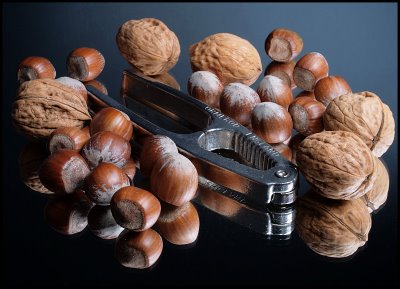Walnuts were introduced into Britain by the Romans. They prized "the mast of Jove" for its nut and the topaz oil that it produced. Medieval monasteries planted walnut trees, and later it was a feature of country house orchards. The wood of the tree was also valued, and is found in high quality veneers showing its lovely swirling burr. For many years a significant number of trees could be found across the country to meet the demand for walnut. However, despite the best efforts of enthusiasts like John Evelyn, by the early twentieth century only one walnut plantation remained in England, near Colchester, Essex. Specimen trees still flourish, and the Walnut Club and others work to popularise this interesting species. The market for walnuts to be eaten has been supplied almost entirely by imports for many years.
The hazel nuts and walnuts above are the last of those bought by me for eating over the Christmas period. On a dull, damp day, engaged on repairs to my fence after heavy winds, I took a break and set up this photograph. I placed the nuts and an old nutcracker on a mirror, put a sheet of black vinyl behind, and bounced the flash off a sheet of white foamboard placed to the right. I used a 70mm (35mm equivalent) macro lens, with the camera set to Aperture Priority (f18 at 1/80 second), with the camera at ISO 100 and -1.0 EV.
photograph & text (c) T. Boughen
